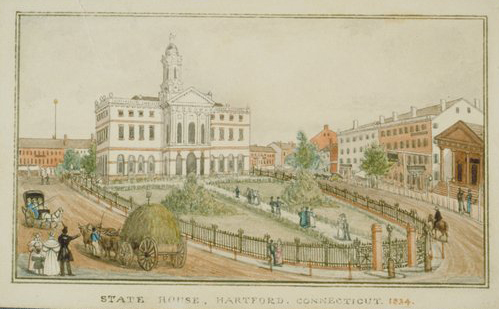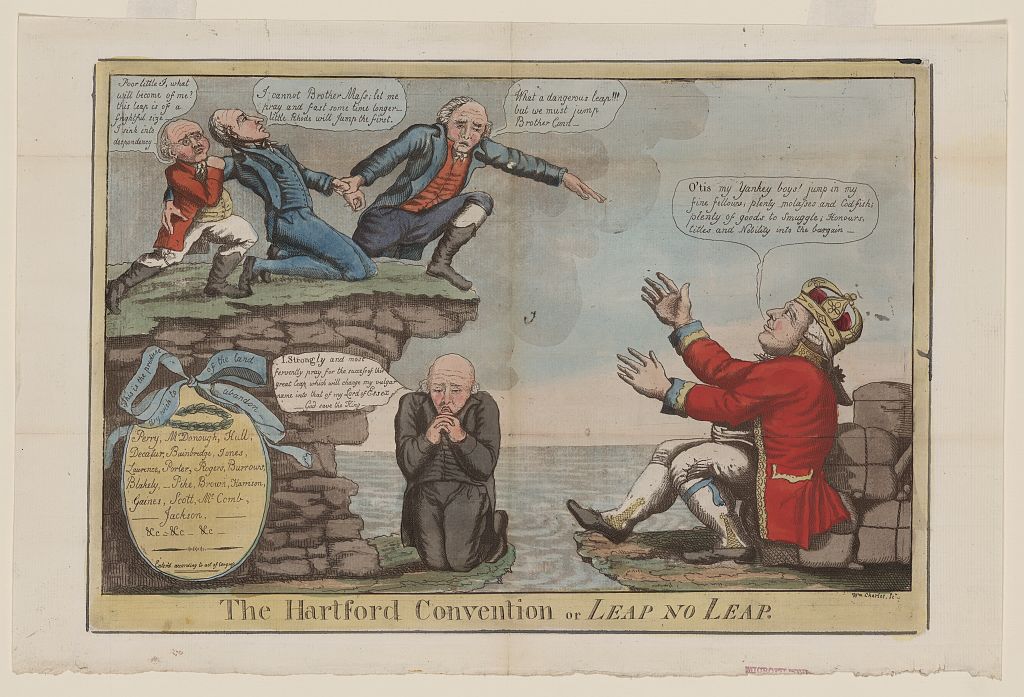Edward Dorgan
Har-Bur Middle School, Regional School District 10
TEACHER'S SNAPSHOT
Subjects:
Early Republic, Foreign Policy, Politics & Government, War of 1812
Course Topics/Big Ideas:
Role of Connecticut in U.S. History
Town:
Hartford
Grade:
Grade 8
Lesson Plan Notes
At the time of the War of 1812, the dominant political party in New England was the Federalists. Republicans Thomas Jefferson and James Madison supported embargos and economic sanctions to address conflict with the British in the early 1800s. The Federalists opposed these policies, which devastated the New England economy built on maritime trade. When the United States and Britain went to war, the New England states refused to put their militias under federal control. In December 1814, delegates from Connecticut, Massachusetts, Rhode Island, Vermont, and New Hampshire met at the Old State House in Hartford to discuss a formal protest to the federal government and propose amendments to the U.S. Constitution intended to better protect the New England states. There were rumors that the delegates to the Hartford Convention might call for secession, but most Federalists took a more moderate view. The convention’s report was issued on January 5, 1815 and read into the records of the U.S. House of Representatives and Senate. Later that month, however, news reached the United States that the war had, in fact, ended with the signing of the Treaty of Ghent on December 24, 1814.
ESSENTIAL QUESTION
SUPPORTING QUESTIONS
- Which policies of President Jefferson and President Madison did the Federalists oppose, and why?
- Why was the Hartford Convention held in December 1814?
- What were the outcomes of the Hartford Convention?
- Did the Hartford Convention have an impact on the War of 1812? On the Federalist Party?
ACTIVITY
- Distribute the “Treason or Not?” worksheets and have students complete the “Do now!” section about the definition of treason.
- Share the link to the “The Hartford Convention – Today in History: December 15.” Working independently or with a partner, students will read the article and answer the “Fact Finder” questions.
- Share the link to the “Leap No Leap” cartoon. Working with a partner, students will analyze the political cartoon and answer the related questions on the worksheet. As an alternative, you can assign each student one of the five characters in the cartoon and have them analyze and share the character and his caption with classmates or in a small group. [Note: for more information about teaching with political cartoons, see the Library of Congress “Analyzing Political Cartoons” Teacher’s Guide.]
- Share the link to the “Amendments to the Constitution Proposed by the Hartford Convention, 1814.” Students will summarize the key points of each amendment in their own words.
- In the final section of the worksheet, students will summarize what they have learned about the Hartford Convention.
OPPORTUNITIES FOR ASSESSMENT
- Students will write an essay responding to the compelling question: “Was the Hartford Convention an act of treason?” Students will include evidence to support their claim.
- In a role-playing activity, students will portray investigators for the U.S. Justice Department. They will formulate arguments regarding whether or not delegates to the Hartford Convention committed treasonous acts against the United States and should be brought-up on charges and present them to the rest of the class.
- Students will select a contemporary issue and create their own political cartoon, along with a paragraph explaining their work.
RESOURCE TOOL KIT

“The Hartford Convention – Today in History: December 15” by Kim Sheriden for ConnecticutHistory.org. December 15, 2015.

William Charles, “The Hartford Convention or Leap no Leap.” c. 1814, etching and aquatint with watercolor. Library of Congress, Prints and Photographs Division. Includes transcription of cartoon captions.

Amendments to the Constitution Proposed by the Hartford Convention, 1814. Courtesy of The Avalon Project, Lillian Goldman Law Library, Yale Law School.

“Treason or Not?” worksheet
ADDITIONAL RESOURCES
Places to GO
Connecticut’s Old State House, Hartford, location of the Hartford Convention in December 1814.
Things To DO
Watch a video: “The War of 1812 in Four Minutes”
Read: Dwight, Theodore. History of the Hartford Convention: With a Review of the Policy of the United States Government Which Led to the War of 1812. New York; Boston: N. & J. White; Russell, Odiorne & Company, 1833.
Websites to VISIT
Connecticut State Library: War of 1812 Service Records
New London County Historical Society: Connecticut and the War of 1812
Articles to READ
“The ‘Notorious’ Hartford Convention” by Matthew Warshauer. Connecticut Explored, Summer 2012.
ConnecticutHistory.org:
- “The Hartford Convention or Leap no Leap”
- “The War Connecticut Hated” By Walter W. Woodward for Connecticut Explored.



